Micro-ATX Cases - Shoebox Showdown
by Joshua Buss on January 2, 2007 12:40 PM EST- Posted in
- Cases/Cooling/PSUs
Antec Aria - Exterior
We've had requests to look at the Aria for well over a year now, but only recently were we able to get enough micro-ATX cases to compare against each other for a full-fledged review. Normally our policy on taking pictures of packaging is that we'd expect any manufacturer to protect their product substantially, and we will only make mention of a product's particular packaging job if it's deplorable or substantially better than average. With the small Aria, we were very happy to see Antec using soft foam blocks rather than typically messy Styrofoam or peanuts, and immediately we had a sense that this case was incredibly tough due to its weight for such a small unit.
The Aria reminded us of the P180 very much - only obviously much smaller - primarily due to its multi-material construction. The frame of the case is mostly steel, but aluminum and plastic are both used for panels and trim pieces. The simple front gives the first clue that the case is smaller than most mATX PCs and even many proprietary SFFs, as it is designed to hold only a single optical drive. There are a couple other key points about the front. All three buttons are plastic but still have a good feel, and the front ports are all nicely spaced apart for larger devices. HDD activity is shown with a blue LED to the right of the reset button, and as long as the system is powered on blue LEDs shine up from the bottom of the slits on the left and right side.
More than just about any other mATX case, the Aria really does resemble a large shoebox in its dimensions. However,,its looks are a little more interesting than dual-tone cardboard. We really like the look the black trim gives the case, and the ribbed top is an interesting touch we've come to appreciate. This top cover is plastic on the top and metal underneath including its grill above the PSU, and the equally hefty side panels are plastic inside and around the edges to dampen vibrations. Thanks to the combination of materials the case is quite resilient to fingerprints for the most part, but the exposed aluminum on the sides is not your typical brushed anodized finish and can pick up smudges or scratches a little easier.
Taking a closer look at the back we can get a sense of the custom-made PSU which allows the Aria to be so compact. Sporting a large fan, the PSU will be able to move plenty of air through the small case without making too much noise. Expansion card retention is done with two standard case screws for a special bracket and one screw for the card itself.
The right side of the case has an impression of "Antec" in the lower right corner and contains the same ventilation perforations as the other side along the bottom. The case's feet are soft rubber and add to the total sound dampening effect as well as keep it from sliding around like some wheeled cases.
More information on the Aria is available on Antec's website.
We've had requests to look at the Aria for well over a year now, but only recently were we able to get enough micro-ATX cases to compare against each other for a full-fledged review. Normally our policy on taking pictures of packaging is that we'd expect any manufacturer to protect their product substantially, and we will only make mention of a product's particular packaging job if it's deplorable or substantially better than average. With the small Aria, we were very happy to see Antec using soft foam blocks rather than typically messy Styrofoam or peanuts, and immediately we had a sense that this case was incredibly tough due to its weight for such a small unit.
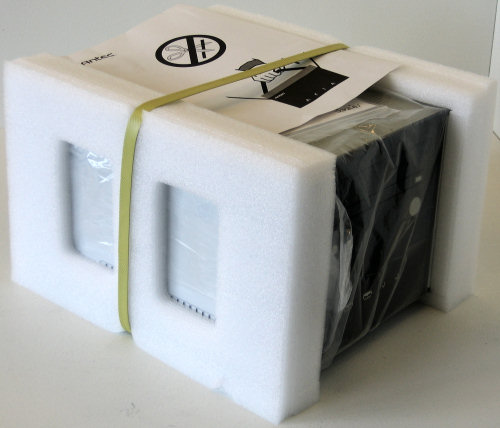 |
| Click to enlarge |
The Aria reminded us of the P180 very much - only obviously much smaller - primarily due to its multi-material construction. The frame of the case is mostly steel, but aluminum and plastic are both used for panels and trim pieces. The simple front gives the first clue that the case is smaller than most mATX PCs and even many proprietary SFFs, as it is designed to hold only a single optical drive. There are a couple other key points about the front. All three buttons are plastic but still have a good feel, and the front ports are all nicely spaced apart for larger devices. HDD activity is shown with a blue LED to the right of the reset button, and as long as the system is powered on blue LEDs shine up from the bottom of the slits on the left and right side.
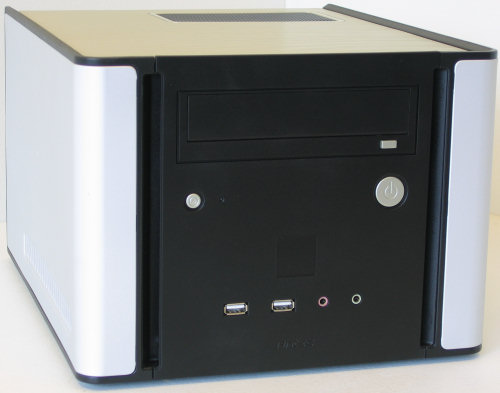 |
| Click to enlarge |
More than just about any other mATX case, the Aria really does resemble a large shoebox in its dimensions. However,,its looks are a little more interesting than dual-tone cardboard. We really like the look the black trim gives the case, and the ribbed top is an interesting touch we've come to appreciate. This top cover is plastic on the top and metal underneath including its grill above the PSU, and the equally hefty side panels are plastic inside and around the edges to dampen vibrations. Thanks to the combination of materials the case is quite resilient to fingerprints for the most part, but the exposed aluminum on the sides is not your typical brushed anodized finish and can pick up smudges or scratches a little easier.
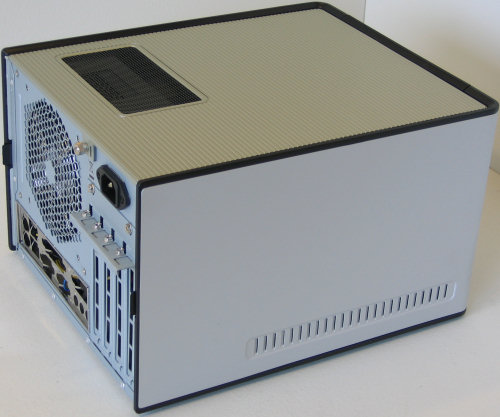 |
| Click to enlarge |
Taking a closer look at the back we can get a sense of the custom-made PSU which allows the Aria to be so compact. Sporting a large fan, the PSU will be able to move plenty of air through the small case without making too much noise. Expansion card retention is done with two standard case screws for a special bracket and one screw for the card itself.
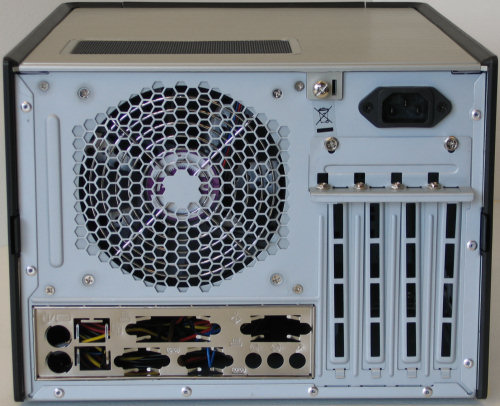 |
| Click to enlarge |
The right side of the case has an impression of "Antec" in the lower right corner and contains the same ventilation perforations as the other side along the bottom. The case's feet are soft rubber and add to the total sound dampening effect as well as keep it from sliding around like some wheeled cases.
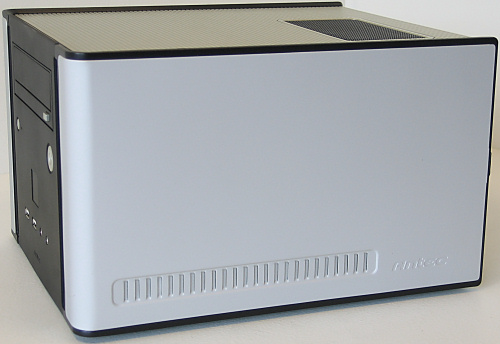 |
| Click to enlarge |
More information on the Aria is available on Antec's website.










37 Comments
View All Comments
shenoyh - Tuesday, January 2, 2007 - link
Just curious..there seems to be enough space and screw-holes for a regular ATX motherboard ...though it would be a tight fit.JarredWalton - Tuesday, January 2, 2007 - link
If it can fit a regular ATX board, it would no longer be a micro-ATX case - at least, that's how I see it.OrSin - Tuesday, January 2, 2007 - link
How can you do a M-ATX review and not have the Sugo in it. Its price is nice and workmanship on par with the Qmicra. With the huge difference in pricing I would think even full systems can be reveiwed.JarredWalton - Tuesday, January 2, 2007 - link
Generally, we review what we get. If Sugo wants to send Josh a case for review, I'm sure he would be happy to include it. Obviously, a look at three cases is not going to be a comprehensive roundup, but it's virtually impossible to include every potential candidate in an article.KingDaPuma - Tuesday, January 2, 2007 - link
Great review. Thanks. I note that the cases were tested with the GeForce 6600GT. Will any of the new DX10 cards (GeForce 8800, ATI R600, etc.) fit within any of these SFF cases?blinkin2000 - Wednesday, January 3, 2007 - link
The 8800GTX Fits but you must cut a hole for power connectors and you loose the lower 5.25" bay, but it fits.blinkin2000 - Wednesday, January 3, 2007 - link
in the microflywilburpan - Tuesday, January 2, 2007 - link
If I read your review correctly, it looks like the main source of noise was from the power supply fan. Would it be possible to replace the fan to try to cut down on the noise? Failing that, are these power supplies proprietary enough so that they can't be swapped out?mpc7488 - Tuesday, January 2, 2007 - link
From the Microfly Final Words: "If you want to use a different full-size ATX PSU, you can get the case only for as little as $50."IMO, accepting a full-size ATX replacement is a huge plus for this case. Everyone I know with a Shuttle cube has had a power supply fail in 1-2 years, they're not that cheap to replace, and output capacities are very limited.
Schmide - Friday, January 5, 2007 - link
Agreed, However I got this case and the funny thing is the X-connect doesn't fit in this case. Aren't these the same brand. Lollerskates...